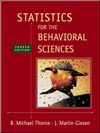 |  Statistics for the Behavioral Sciences, 4/e Michael Thorne,
Mississippi State University -- Mississippi State
Martin Giesen,
Mississippi State University -- Mississippi State
Alternatives to t and F
Chapter Overview| Nonparametric alternatives to t and F are useful when the data are ordinal scale, ease of computation is
desired, or the samples are small and have unequal Ns. Small samples often have a large amount of
variability, which makes resulting t ratios and F ratios relatively small. By avoiding a measure of
variability, a nonparametric test may be more powerful than the corresponding parametric test with small
sample sizes and outliers (extreme scores).
The Mann-Whitney U test is a useful alternative to the two-sample t test for independent samples when
the measurement level is ordinal and the normality assumption cannot be made. The M-W assumes that the
samples are independent, that there is an underlying continuous measurement scale, and that the
measurement scale actually used is at least ordinal. The tested hypothesis is that the populations from
which the samples are drawn are identical in shape. If the populations are identical, then if we rank the
combined observations from two samples, the scores from the two samples should be evenly mixed in the
combined ranking. If the scores are not evenly mixed, then they probably come from different populations.
The computed U is a measure of how evenly mixed the scores from the combined samples are, with a
low value indicating a lack of mixing. Thus, unlike the previous significance tests, the null hypothesis is
rejected if U (or U') is equal to or less than values from Table H (see Appendix 2). With samples
containing more than 20 observations, U is converted to a z score. The null hypothesis is rejected if the
computed score is equal to or larger than 1.96 (two-tailed test at the 5% level) or 1.64 (one-tailed test at the
5% level).
The Wilcoxon matched-pairs signed-ranks test is a nonparametric alternative to the t test for dependent
samples. The test assumes that the subjects are randomly and independently selected, that there is at least
ordinal scale measurement, and that it is possible to rank-order the difference scores (difference between a
pair of scores). The tested hypothesis is that the distributions of the populations under each condition are
identical.
First, the difference between each pair of scores is found, with 0 differences discarded. Next, the
absolute values of the difference scores are rank-ordered, but the signs are retained. The ranks with the less
frequently occurring sign are summed, and the resulting T is compared with table values in a significance
test. If the population distributions are really identical, there will usually be about the same number of
positive and negative differences, and the sums of the ranks for the positive and negative differences will
not be very different. However, if the distributions are dissimilar, there will be many more differences of
one sign than of the other. Thus, the smaller the sum of the less frequently occurring ranks, the more likely
that the population distributions are different. If the computed T is equal to or smaller than the critical value
in Table I (see Appendix 2), the null hypothesis is rejected. For samples larger than 25, the distribution of T is approximately normal, and T is converted to a z score. H0 is rejected at the 5% level if z is 1.96 or larger
in a two-tailed test (1.64 in a one-tailed test).
The Kruskal-Wallis one-way analysis of variance by ranks is an extension of the Mann-Whitney test
for comparing more than two independent groups. A statistic, H, is computed, and if there are three groups
with at least five subjects per group, H is distributed approximately as c2. After a significant H, further
testing with the M-W test will reveal the between-group differences. |
|



 2003 McGraw-Hill Higher Education
2003 McGraw-Hill Higher Education